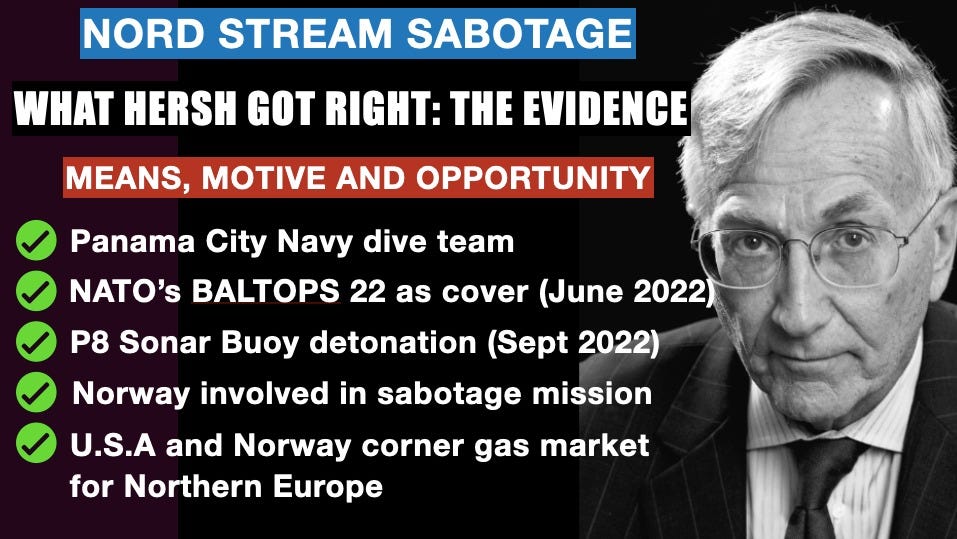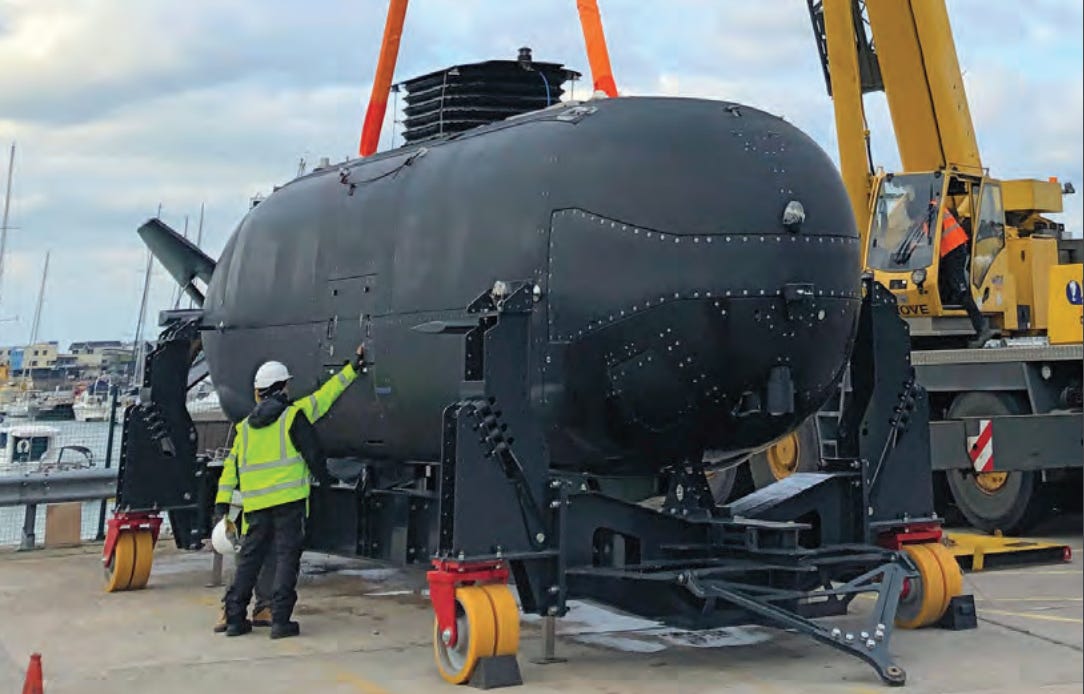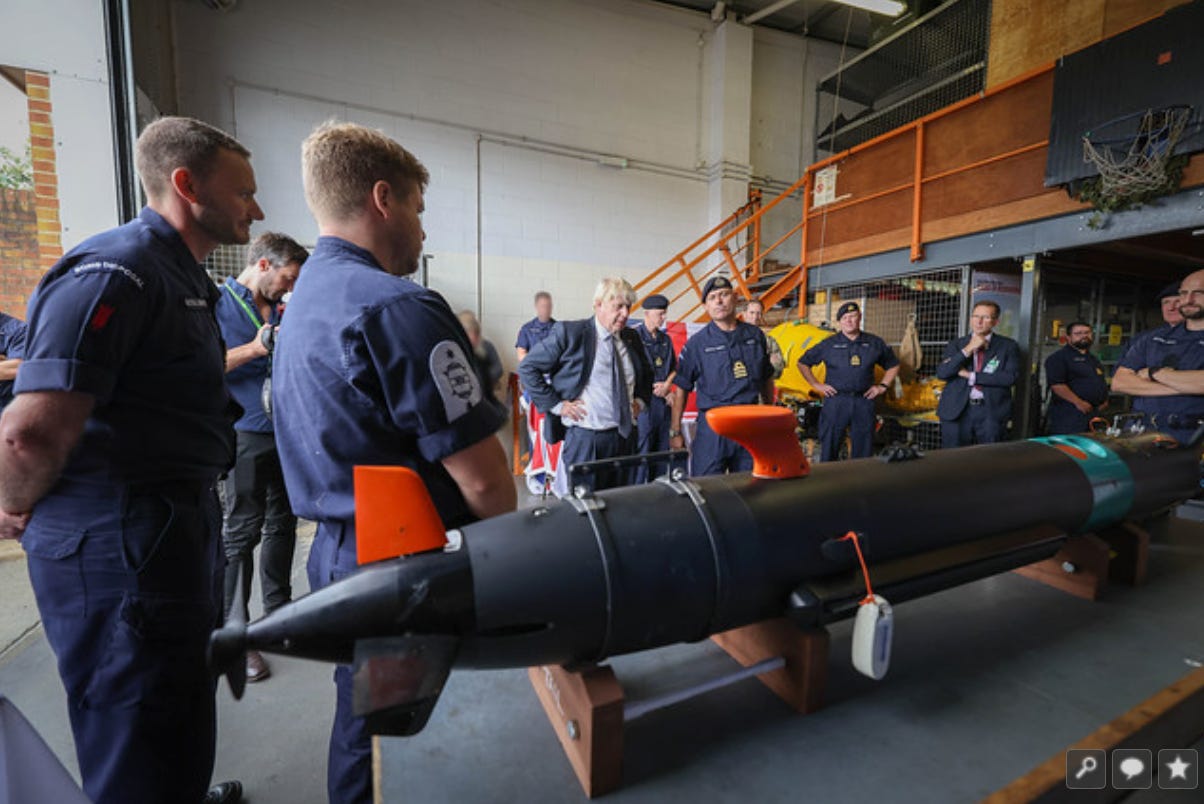PART 2 – Smoking Guns: Nord Stream Sabotage ‘Secret Teams’ Revealed
investigation’s aim was to put a face on some of the key story points made by renowned investigative journalist Seymour Hersh
Get comfortable as you are about to embark on Part 2 of our investigative report into the Secret Team behind the Nord Stream pipeline sabotage operation. Despite facing the large swell of propaganda coming from the legacy media and their sudden renewed interest in the Nord Stream attack, we hope readers will appreciate the evidence-based, more realistic picture presented here regarding what an actual CIA-backed covered operation entails, as we identify the likely platers, aiders and abetters from participating NATO members states.
After having laid down the foundation of our investigation in Part 1 of the Nord Stream Pipeline Sabotage, in Part 2 of our investigation we’ll refocus on the actual operational, technical and logistical aspects of this US-led NATO mission which must be considered if we are to properly identify those who had not only the means and motive but also the opportunity to take out, once and for all, the German-Russian joint venture Nord Stream pipeline system in the Baltic Sea, detonated in the wee hours of 26 September 2022.
Initially, our investigation’s aim was to put a face on some of the key story points made by renowned investigative journalist Seymour Hersh in his Nord Stream incident report published on 8 February 2022. In Part 1 of our investigation, we presented data and evidence which validated the main elements of Hersh’s story, including the CIA-led Navy diving team out of Panama City in Florida, and also that the explosives were planted on the Nord Stream pipelines at a depth of 260 feet just a few miles off the coast of Denmark’s Bornholm Island – under the cover of the annual NATO BALTOPS-22 drill in the Baltic Sea held in June 2022. We also confirmed the validity of Hersh’s accusation that NATO ally Norway was in fact intimately involved in this covert military operation.
There were parts of Hersh’s story which we did not go into detail in Part 1 of our investigation, but which we have been able to do here. This includes substantiating Hersh’s claim that the C4 explosives attached to the pipelines during the BALTOPS exercise in June would be triggered in late September by a sonar buoy dropped by a Boeing Poseidon P8 aircraft. We will also demonstrate how specialists from the deep sea oil and gas industry were also consulted and would have, at least, participated in the planning of this operation. In addition to this, we will also show how NATO member Denmark was also involved in the operation as well, as well as the cover-up alongside its close Nordic neighbour Sweden.
Throughout this investigation, our strategy was never to crunch large amounts of flight data, or military and commercial ship logistical data, as there are many capable researchers who specialise in these areas, and we will be highlighting their work accordingly. Rather, our strategy here is to review as much available and pertinent evidence we could gather, which has turned out to be substantial, while sticking to a plausible and common sense-based analysis, and see where this approach would eventually take us.
In this article we will show how a CIA-led operation with highly trained divers and the latest Dry Combat Submersible (DCS) technology, was able, with the help of NATO allies, to operate under the cover of a major NATO Naval exercise BALTOPS-22, to take out the Nord Stream pipelines. In order to further validate Hersh’s story, we must first prove that NATO possessed all of the equipment and teams necessary, that these were all mission capable, and that they were positioned at the crime scene during BALTOPS-22. The following evidence and corresponding analysis will demonstrate the following:
• We will show you how a “Made in Britain” Dry Combat Submersible (DCS1) funded by US-SOCOM (US Special Operation Command Program UOES2 – DOCK1) could have taken a team of highly trained Navy Seals and Saturation Divers who are experts in Explosive Ordnance Disposal (EOD) onto the Baltic Sea floor at the site of the Nord Stream pipelines during NATO’s BALTOPS 22 naval exercise.
• We will review US Navy SEAL involvement, along with the UK’s Alpha, Bravo, Delta & Echo, and Charlie Squadron diving units from the British Royal Navy Diving & Threat Exploitation Group (DTXG) and the various roles they may have played with their US, Norwegian and Danish counterparts, bringing expertise in Maritime Explosive Ordnance Disposal (EOD) to the Nord Stream mission. We will also review the capabilities of the British Royal Navy’s DTXG ‘Bravo Squadron’ which provides support for another essential component of this operation: the NATO Submarine Rescue System, a joint UK, Norway and French Submarine Rescue System program sponsored by the UK Department of Defense.
• We will also answer the important question: was the Nord Stream sabotage operation the result of a public and private partnership? If so, then which firms provided the operational capability for this mission? We will review the potential role of British companies such as MSubs (Submergence group), Forum Energy Technologies (FET) and James Fisher Defence (JFD), a world-leading underwater capability provider serving the oil and gas industry as well as the Defence diving markets.
• In order to prepare for the Nord Stream mission, we can reveal the role of the US Navy’s Operational Test and Evaluation Force OPTEVFOR, the US Expeditionary/Littoral Warfare Division and their SEAL/EOD/Dive/Riverine Section which are testing the US Submarine Rescue Diving and Recompression System (SRDRS) but also Deep (dry) Combat Submersible (DCS). This would be the same equipment used for special ops by the Navy SEALs and U.S. Navy Explosive Ordnance Disposal Mobile Unit (EODMU) 8.
• Why is it important to understand the decompression challenge when using a Dry Combat Submersible (DCS) and performing saturation dives down at 260 – 330 feet? We will review the process and the challenges for successfully completing the Nord Stream mission.
• Evidence of U.S. Navy divers assigned to mission capable Explosive Ordnance Disposal Mobile Unit “EODMU 8” and Royal Danish Navy divers assigned to Mine Counter Measures (MCM) Denmark Dive Team meeting with mission capable Norwegian Reine-Class patrol vessel called Magnus Lagabote (A 537) to conduct a decompression exercise.
• What were the Norwegian Oksøy-class mine hunters M343 Hinnøy doing in the Nord Stream Pipeline blast zone on May 22, 2022, 15 days prior to the launch of BALTOPS 22?
• We will answer the question: what was the role of the Naval Oceanography Mine Warfare Center (NOMWC) which collaborated with BALTOPS 22 NATO teams for mine countermeasures (MCM)? This will include the important detail of pre-deployment of these units, and the importance of controlling the underwater environment/conditions and establishing a special operation diving perimeter ahead, and during, a covert mission. Understanding why so many Unmanned Underwater Vehicles (UUV) were used off the shores of the Bornholm Island of Denmark.
• We will demonstrate how a successful sabotage operation would require direct consultation and involvement of deep water pipeline installation and maintenance specialists from the oil and gas industry, and see exactly their take on the destruction of the Nord Stream pipeline. Learn what it actually requires to perform deep-water dives on pipelines (video evidence).
• We will clearly demonstrate exactly how data crunching and open source tracking tools can help identify the military aircraft involved in the dropping of SonoBuoys (sonar buoys) to ‘delay-trigger’ the explosions that destroyed the Nord Stream pipelines and see how one OSINT aircraft watcher was able to track down a mysterious US-made P8 Poseidon aircraft directly above the Nord Stream pipeline which needed to be refuelled in the air in order to complete a ‘drop and go’ mission described in Seymour Hersh’s report.
• CUI BONO? Who are the economic and geopolitical beneficiaries of the Nord Stream sabotage attack, and how does the NS2 sabotage fit perfectly with the European Union’s ‘New Green Industrial Plan’?
In order to prove Hersh’s story was not only plausible but very accurate, is not enough to understand the political and geopolitical context of this event. To understand how this complex covert operation was successfully executed, we must now identify the specific technology and equipment which had to have been used to carry out the mission within the given time and environmental parameters.
Dry Combat Submersible (DCS) Program (UOES2) and Their Diving Teams
To understand how this operation was carried out, we must first acknowledge that U.S. Special Operations Command (US-SOCOM) has been engaged in a Dry Combat Submersible (DCS) program since 2018. This provides the first building block of the operation to take out the Nord Stream pipelines.
This Naval Special Warfare (NSW) program was known as UOES2 (User Operational Evaluation System) and was designed to provide solutions for the covert insertion and recovery of Special Operation Forces (SOF) from ‘denied’ areas. By reducing operator exposure to the underwater environment, the DCS improves mission endurance and range over existing small submersibles which made it the ideal replacement for the Seal delivery system (SDV), a crewed submersible and diver delivery vehicle used to deliver US Navy SEALs and their equipment on covert missions for underwater demolition.
The Dry Combat Submersible (DCS) Block I Program is active and fully funded, and consists of three boats with a dry and warm interior (unlike the MK 8 and MK 11 SDVs that have their interior crew and passenger compartments flooded to the outside ocean water temperatures). DCSs allow for a crew of two (pilot and co-pilot) and up to eight SEAL passengers to have “less impact to the diver in transit to maximize their operational time on station.” (source)
The DCS currently further enhances the Special Operation Forces (SOF) mission capability with additional payload capacity (for equipment and explosives needed to execute this mission). In 2021, DOT&E approved IOT&E test plans for at-sea testing and shore-based cyber survivability testing, however, assessment results are classified. In February 2022, the US Navy Operational Test and Evaluation Force OPTEVFOR completed cyber survivability tests consisting of a cooperative vulnerability and penetration assessment and an adversarial assessment of the UK-based, US-SOCOM approved defence contractor MSubs and its S351 NEMESIS DCS1. Data from preliminary assessment of operational effectiveness are yet to be released, but will very likely remain classified.
US-SOCOM announced in 2021 they were putting their new Dry Combat Submersible (DCS) Block 1(S361 NEMESIS and other DCS) through testing in preparation for delivery that autumn. James Smith, acquisition executive for US-SOCOM, speaking on May 17, 2021, with reporters in a roundtable of the National Defense Industrial Association’s Special Operations Industry Conference, said: “The first submersible, DCS1, is finishing up Developmental Test and will begin Operational Test this summer” (meaning summer 2021), adding that “SOCOM is working on ‘pre-program activities’ for DCS-Next generation, which is planned as a Dry Combat Submersible that will be able to operate from submarines”. (source: SeaPower Magazine)
US- SOCOM Block 1 for Dry Combat Submersible (DCS) under program designation UOES2, was not designed for this mini-submarine to be launched from a large submarine – but rather from a MOSHIP (multi-role Navy ship), or a dock with the assistance of cranes.
Msubs are manufactured at a facility located in Estover, Plymouth, Devon England, a short drive from British Royal Navy Base Devonport, Plymouth (UK) where one of the best British Royal Navy explosives exploitation diving expert teams known as RN Diving & Threat Exploitation Group (DTXG) are located.
The UK Ministry of Defence (UK DOD) is known to have acquired a mix of REMUS 100s and REMUS 600s Unmanned Underwater Vehicles (UUV) for mine countermeasure operations over the last 20 years. Since Huntington Ingalls Industries (HII) acquired Hydroid Inc from Norwegian DOD contractor Kongsberg, they have sold more than 600 UUVs to some 30 countries worldwide, including sales to 14 of the NATO member countries, including the UK (source).
Royal Navy DTXG’s explosives exploitation diving experts are also known as the “Echo & Delta Squadron” and were led by Lt-Commander Tom Forbes at the time of BALTOPS 22 (although it’s possible that he might have been replaced by Lieutenant Commander Dave Starkey). Also, the DTXG Alpha Squadron for special operations is led by Royal Navy Lieutenant Commander Martin Seal, whilst the commanding officer of the overall Diving & Threat Exploitation Group (DTXG) is Commander Sean Heaton. Moreover, the DTXG Bravo Squadron works out of HMNB Naval Base Devonport, Plymouth, presently under the command of Lieutenant Commander Nathan Isaacs.
Confirming the presence of the Dry Combat Submersible military equipment at BALTOPS is crucial in understanding how this operation could have been carried out under these specific conditions. In Part 1, we established that the company MSubs (Submergence Group) manufactures Dry Combat Submersible (DCS) SEAL Delivery Vehicle (SDV) for US-SOCOM (US Special Operation Command). Msubs DCS S351 Nemesis went through extensive trials with USSOCOM under the program designation UOES2. More here on DCS.
On the 2nd August/2022 Prime Minister Boris Johnson visited the Diving & Threat Exploitation Group (DTXG) at the UK Defence Diving School, Horsea Island (North shore of Portsmouth harbour). During the visit, he was briefed on the current activities of the Royal Navy’s Mine Clearance Diver specialisation and also a capability demonstration. HMNB Portsmouth. Advanced diver training in the UK is conducted at Weymouth, Falmouth, Plymouth and the west coast of Scotland.
Was Boris Johnson coming to congratulate his boy for the BALTOPS 22 Nord Stream Pipeline job? Time will tell…
Go paid at the $5 a month level, and we will send you both the PDF and e-Pub versions of “Government” - The Biggest Scam in History… Exposed! and a coupon code for 10% off anything in the Government-Scam.com/Store.
Go paid at the $50 a year level, and we will send you a free paperback edition of Etienne’s book “Government” - The Biggest Scam in History… Exposed! AND a 64GB Liberator flash drive if you live in the US. If you are international, we will give you a $10 credit towards shipping if you agree to pay the remainder.
Support us at the $250 Founding Member Level and get an Everything Bundle – The Sampler of Liberty! - Get it free by going paid as a Founding Member!
Give me Liberty... and give me more! The Everything Bundle includes the latest version of our flagship book on government, along with a collection of potentially life-altering introductions to voluntaryism, agorism and peaceful anarchy.
“Government” – The Biggest Scam in History… Exposed! by Etienne de la Boetie2
Anarchy Exposed! - A former police officer reports on his investigative journeyby Shepard the Voluntaryist and Larken Rose
The Most Dangerous Superstition by Larken Rose
Sedition, Subversion and Sabotage – Field Manual #1 by Ben Stone, The Bad Quaker, and Ken Yamarashi
What Anarchy Isn’t– A short pamphlet by Larken Rose… The perfect introduction to peaceful anarchy
Three Friends Free – A Children’s Story of Voluntaryism
The Liberator is a 64GB wafer flash drive filled with books, documentaries, podcasts, MP3s, short videos, and music from the truth movement’s leading artists. The credit card-sized format makes it convenient to keep in your wallet to share and copy easily.












